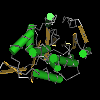?
 
phosphoserine phosphatase (PSP), similar to Methanococcus Jannaschii PSP and Saccharomyces cerevisiae SER2p This family includes Methanococcus jannaschii PSP, and Saccharomyces cerevisiae phosphoserine phosphatase SER2p, EC 3.1.3.3, which participates in a pathway whereby serine and glycine are synthesized from the glycolytic intermediate 3-phosphoglycerate; phosphoserine phosphatase catalyzes the hydrolysis of phospho-L-serine to L-serine and inorganic phosphate, the third reaction in this pathway. This family belongs to the haloacid dehalogenase-like (HAD) hydrolases, a large superfamily of diverse enzymes that catalyze carbon or phosphoryl group transfer reactions on a range of substrates, using an active site aspartate in nucleophilic catalysis. Members of this superfamily include 2-L-haloalkanoic acid dehalogenase, azetidine hydrolase, phosphonoacetaldehyde hydrolase, phosphoserine phosphatase, phosphomannomutase, P-type ATPases and many others. HAD hydrolases are found in all three kingdoms of life, and most genomes are predicted to contain multiple HAD-like proteins. Members possess a highly conserved alpha/beta core domain, and many also possess a small cap domain, the fold and function of which is variable. HAD hydrolases are sometimes referred to as belonging to the DDDD superfamily of phosphohydrolases. |
